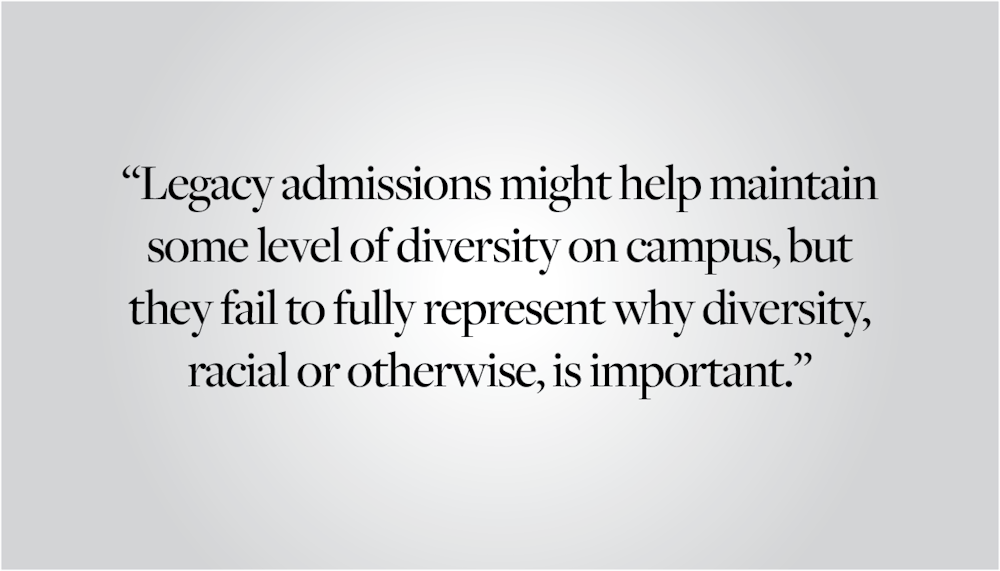With the Supreme Court poised to strike down race-conscious admissions, Brown is considering a number of alternative strategies to uphold student body diversity without affirmative action. Associate Provost for Enrollment Logan Powell, at a recent panel, suggested that the University rely on legacy admissions — the practice of giving the relatives of alumni an advantage in admissions — as part of its response. But this plan would fail to ensure the campus diversity Brown seeks to uphold and perpetuate socioeconomic inequities on campus. Further reliance on legacy admissions should have no place in Brown’s overall response to the end of affirmative action.
Powell argued that Brown has admitted “increasingly diverse classes of students, which means that their children are increasingly diverse.” The argument here seems to be that, by increasing legacy admissions, the University could generate a trickle-down form of diversity, where enrolling the children of alumni allows student demographics of coming generations to reflect previous ones.
Dubbed “affirmative action for whites” and “affirmative action for the rich,” legacy admissions have historically perpetuated socioeconomic disparities. First instituted in response to an increase in Jewish and Catholic applicants to top American universities, legacy admissions have since been giving a significant leg up to students who, by definition, have highly-educated parents, likely with high-paying jobs.
Brown students have long opposed legacy admissions at Brown, through campaigns like #LeaveYourLegacy and groups like Students for Educational Equity. Student group leaders have described legacy admissions as reinforcing “a cycle of inequity.” It is ironic that Brown would now offer the policy as part of a solution to the exclusivity and inaccessibility of higher education when Brown students have spoken against the practice for contributing to precisely that issue.
Powell indirectly demonstrated this at the panel: he said that one-third of the legacy students and student-athletes on campus self-identify as students of color — but failed to mention that this is in comparison to the 48% of the class of 2025 that do. In other words, legacy admits are substantially whiter than Brown’s overall student body. The level of diversity that legacy admissions could sustain is ultimately still a significant step-down.
However, perhaps the most troubling consequence of turning to legacy admissions is that such a move fundamentally misunderstands the function of affirmative action in the first place. Race-conscious admissions, the policies we recognize today as affirmative action, were designed to address historical inequalities in the education system that prevented students of color and first-generation college students from applying and matriculating at highly selective colleges. These policies were about racial equity, certainly, but also about socioeconomic equity. They acknowledged how the history of American racial politics has consolidated wealth in white households and reinforced race- and class-based disadvantages that require active correction.
Even if Brown’s legacy admits are more racially diverse in 2030 than they were in 1960, it does not change the fact that legacy admissions privilege the wealthy. This favoritism directly contradicts the historical purpose of affirmative action, as well as what Brown set out to do in 1969 when it pledged to recruit an undergraduate class that was representative of the national population, after a 1968 walkout by 65 Black students protesting the lack of diversity in admissions. The University at the time explicitly pledged to recruit additional Black applicants from “all economic and social levels.” This was an acknowledgment that a Brown education does not only belong to white students, nor does it only belong to those who can afford SAT prep classes nor to those whose parents walked through the Van Wickle Gates.
Even if we ignore the practical failings of Powell’s argument for legacy admissions, we cannot dismiss what affirmative action is about at its core — the just reallocation of resources. Legacy admissions might help maintain some level of diversity on campus, but they fail to fully represent why diversity, racial or otherwise, is important.
So, if affirmative action is taken off the table and legacy admissions won’t meaningfully ensure diversity at Brown, what should the Office of Admissions emphasize instead? As it turns out, there are a number of measures that the University is already considering to draw in talented students from across the country, rather than from within alumni families. As Powell noted during the panel, expanded recruitment in southern and southwestern cities in partnership with Howard University will allow the University to reach students from a wider variety of geographic and socioeconomic backgrounds, increasing the diversity of the overall applicant pool. Furthermore, Brown must continue to invest in the students of color, as well as first-generation, low-income and undocumented students who are already on campus, by providing resources to the Brown Center for Students of Color and the U-FLi Center. These represent more promising paths forward than doubling down on legacy admissions.
Editorials are written by The Herald’s Editorial Page Board. This editorial was written by its editor Kate Waisel ’24 and members Irene Chou ’23, Yasmeen Gaber ’23, Tom Li ’26, Jackson McGough ’23, Alissa Simon ’25 and Yael Wellisch ’26.





